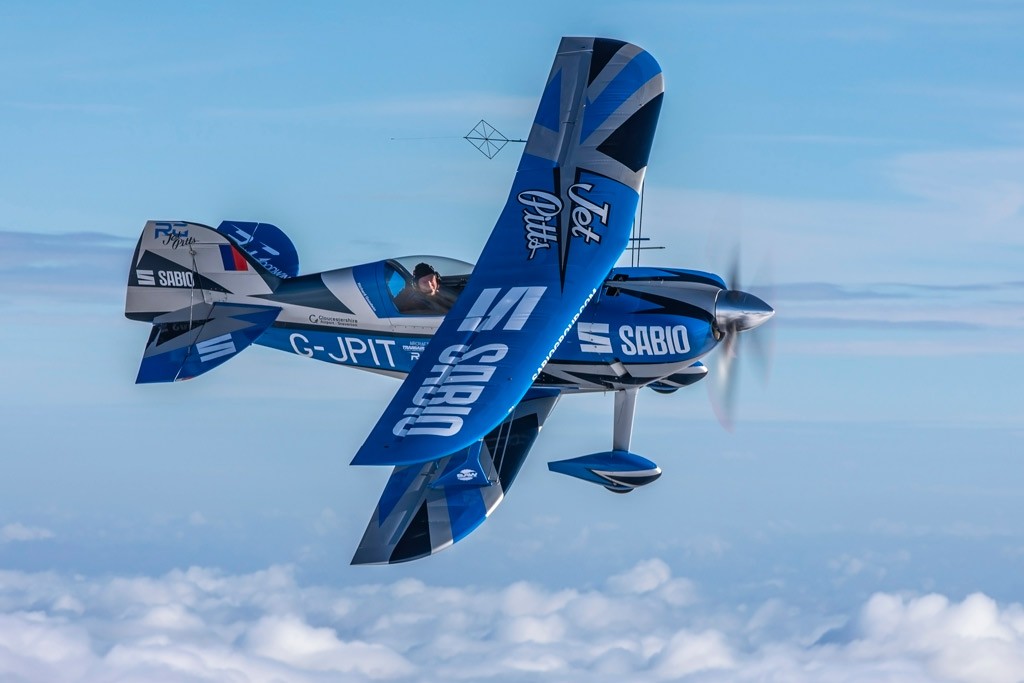Helping Rich Goodwin Reach New Heights With His Aerobatic Biplanes

Air shows continue to be popular events for enthusiasts and the broader British public.
In 2019, almost five million people attended various events across the UK, making air displays the third largest outdoor spectator activity in the country, second only to football and horse racing.
It is also estimated that air shows, which range from small local events featuring one display act right through to major seaside festivals, trade events and international military displays, contribute well over £100 million to the economy every year.
Richard Goodwin is a regular participant on the circuit. A retired RAF Tornado pilot and commercial pilot at TUI for 26 years, he has since moved into the world of developing and demonstrating aerobatic aircraft at shows, typically displaying at most major air shows in UK as well as international events in the likes of Gibraltar, the Channel Islands, Sanicole in Belgium, and the UAE.
The decision to move on from the commercial arena was sparked by a trip to America. “I saw a particular type of air show act and I wondered why that wasn’t possible in the United Kingdom,” Goodwin recalled.
“Understandably, there is a lot of regulations to adhere to making it very hard to modify aircraft in the UK and in Europe. That was the challenge. It’s all the small incremental changes we build into the aircraft that make it the Ultimate Aerial Entertainer for airshows. In order to make it at the air show level, you need to have something a bit different.”

Rising to the challenge
Richard flies two types of aerobatic biplanes, originally designed in 1947 with two main wings stacked one above the other to give it structural strength.
The first, G-EWIZ, is a 700kg aircraft powered by a six-cylinder, 8.5 litre engine that produces more than 300hp and a top speed of over 200mph. The aircraft, which was built from a kit of parts in Australia in 1982, has been continuously modified and improved during the decade or so it has been used by Rich.
G-JPIT has been built from scratch over the past five years. Incorporating the successful modifications made to the G-EWIZ, its wing design is what sets it apart, with larger ailerons and an expanded wing area giving a superior roll rate and better low speed handling.
In a bid to offer that something different, he has spent the past four years developing new jet engine installation for G-JPIT. The two ATM Lynx Jet turbines will deliver 700lbs of thrust and, in combination with the 8.5 litre engine, a total thrust of 1,700lbs – an impressive feat for an aircraft that weighs just 1,550lbs.
To date, this has been a process which has involved copious amounts of testing, certification and regulatory back and forth with various authorities. However, Rich now has the green light to operate test flights, a crucial step towards turning his dream project into a reality and flying the modified aircraft at shows in front of spectators.
A key challenge he has had to overcome is ensuring that the new jet engines do not overheat the tailplanes. To demonstrate his aircraft is fit and safe to fly at shows, Rich needs to monitor, log and supply data from test flights on two different surfaces – the tail of the plane (which cannot go above 75 °C) and the gas turbines.
“I was looking for something to perform the task of data logging,” he explained. “The turbines go up to about 850 °C, and when we first set them up on the aeroplane it would basically melt anything in its path. In response, we’ve angled the turbines out as much as we can without losing too much thrust.”

ThermaQ Blue proves its worth
To monitor temperatures during test flights, Richard has installed a ThermaQ Blue thermometer into the cockpit of the plane with wired thermocouple probes fixed to the tailplanes.
One of ETI’s newer products, ThermaQ Blue is designed to monitor temperatures remotely, transmitting temperature data to wireless iOS, Android or Bluetooth devices via a secure connection of up to 50 metres.
As Rich commences test flying, he will film his routine with a GoPro whilst recording the tailplane temperatures in the ThermaQ app to paint a picture of how different manoeuvres affect the temperature. The data gathered will be downloadable into an Excel spreadsheet and serve as a vital component of Rich’s bid to acquire approval for flying at air shows.
“Rather than me sitting there with a pen and paper, it’s useful for me to be able to data log it and record it against the video of the routine,” he added. “I’m hoping that these temperatures aren’t going to be an issue and that we’re not going to see above 65 °C at any altitude or during any manoeuvre.”
Learn more about Rich Goodwin Airshows.
You might also like:
Tyre Temperatures: The Key to Motorsport Success
Supporting LegionellaDossier in its Work to Make the Water Industry Safer